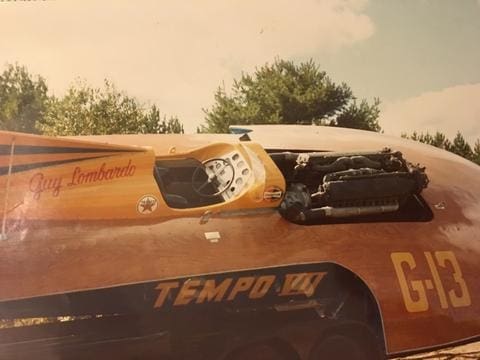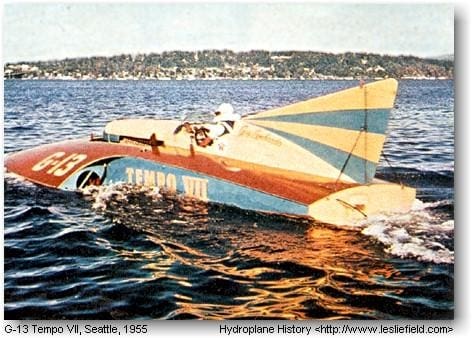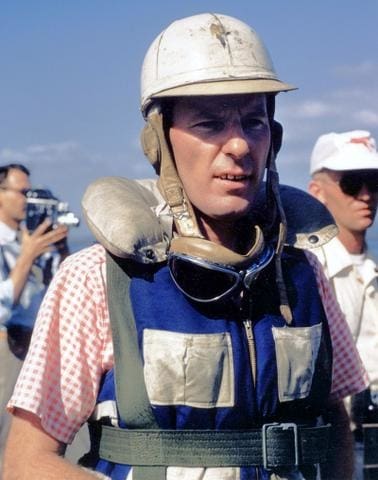The Sweetest Boat This Side of Heaven: Restoring Guy Lombardo's Tempo VII
Posted on February 02 2016

These days, if they’ve heard the name at all, most people associate Guy Lombardo with music. Not without reason – Guy Lombardo and his Royal Canadians sold hundreds of millions of records in their heyday, and from 1924 to 1976 they were synonymous with New Year’s Eve. Lombardo and band presided over the iconic ball drop in Times Square, and their version of “Auld Lang Syne” is still the first song that plays after midnight hits.
That resumé is impressive enough, but Lombardo managed to fit in a second distinguished career. Having inherited a competitive instinct from his father and brother, who owned and raced horses, he also made a name for himself as a hydroplane speedboat racer. He won major Gold Cup and Ford Memorial victories as a driver, eventually picking up every trophy in the field. In many of these competitions he drove his first six boats up to Tempo VI, followed in 1955 by the Tempo VII.
Dubbed “the Sweetest Boat this Side of Heaven” (a nod to the Royal Canadians’ slogan, “the sweetest music this side of Heaven”), the hydroplane was built by Les Staudacher, who had a woodworking business specializing in church pews. With input from Lombardo and Foster, Tempo Vll was outfitted with a 2400 horsepower Allison V1710 engine, the same that powered P38 Lougheed Lightning Bombers in World War II. In the new craft Lombardo seemed primed for even greater glories, but his dual careers clashed when Decca Records told him insurance contracts prohibited him from driving speed boats. Thus began a collaboration with former rival Danny Foster, who proved much more than just a gifted driver.

Photo from www.jetaircraftmuseum.ca
Foster introduced a number of innovations to the Tempo VII, such as the fist prop rider, a small prop that spins fast. In the 1956 season no one could figure out why he and Lombardo were winning, because the duo had a diver go down and remove the prop before Tempo VII was hauled out of the water. Foster also did some fine-tuning on the needle in the carburetor. The size of the needle in the aircraft engines was intended for performance at high altitude, not at sea level. With a little optimization for the new conditions, Foster coaxed still more speed out of the motor.
A third design change he made was to cut big holes in the sponsons, an area of the boat that was hard to seal at speeds of 150 miles per hour. Foster solved this long-standing problem by cutting holes in the back of the sponsons, so that the water which flooded in when the boat was at rest would clear out at high speed. With Foster in the cockpit, Tempo VII and the Lombardo team won six first-place races, including the Copper Cup, Silver Cup, President’s Cup, and International Cup, as well as numerous exhibitions. After each race, Foster would clamber out and join Lombardo to hustle records.

Foster in his heyday (photo from http://thunderboats.ning.com)
Lombardo eventually retired from competitive racing and sold the boat. It must have languished for a time, because according to a 1982 article in the Bancroft Times, Bancroft resident Ross Therrien acquired it in 1981 from “an obscure New York junkyard” and towed it home. Ross relayed the story to us personally when he called from a highway payphone at 4 a.m. to ask if we could open up the workshop — he was towing his acquisition from New York State and needed to get if off his Jeep. Tempo VII was so large it necessitated its own hydraulic trailer, which tilted the boat on its side so it could be towed legally on the highway. The weight of it had crunched the frame of Ross’ Jeep, and he had to crawl out the window to make his call. He asked if he could leave Tempo VII with us to complete a visual restoration so he could tell the boats history and display it at shows.
The boat was in rough shape – literally rotting and filled with a layer of dead leaves. It would take a replica engine (which we were able to locate in like-new condition left over from the second World War), new oak frames, a redone mahogany plywood exterior, and a new aluminum bottom skin to restore Tempo VII, visually at least, to its former glory.
After we finished the work, we lost track of Tempo VII for awhile. We were reminded of it when Don Gaudier of Woodstock emailed us to ask about the brass plate we installed to mark the restoration. It seems Tempo VII had encountered some tough times and had languished for a period in a municipal storage depot in London, Ontario. Fortunately for boat enthusiasts, Tempo VII was rescued from obscurity and is now proudly on display at the Jet Aircraft Museum, courtesy of the London Heritage Council.Fortunately for boat enthusiasts, Tempo VII was rescued from obscurity and is now proudly on display at the Jet Aircraft Museum, courtesy of the London Heritage Council.
Not long after the restoration we met Danny Foster in person at a boat show in Manotick. Though he was seventy-five at the time, he gave us an adrenaline-fueled ride in a hydroplane of his own design. Nothing compares to the sensation of pure speed these boats provide. We’re happy to help keep the history alive, especially through a boat as storied and formidable as Tempo VII.

Ted and Daisy pose with Tempo VII at the Toronto Boat Show 1982
